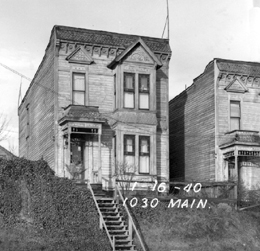On March 13, 1939, the Seattle City Council passes a resolution establishing the Seattle Housing Authority (SHA) and eight months later signs an agreement under which the SHA will provide housing for low-income and disadvantaged citizens in the city. It is the first public-housing authority in the state and in May 1939 receives $3 million to develop Yesler Terrace. Public-housing activist Jesse Epstein (1910-1989) chairs the new housing authority commission. By 2009, the SHA expands to house 26,000 residents at more than 400 sites.
New Deal for Housing
The Seattle Housing Authority was created through the U.S. Housing Act of 1937, which provided public-housing subsidies to eliminate substandard housing and to stimulate the building industry. It was part of President Franklin Roosevelt's (1882-1945) New Deal legislation, designed to jump-start the nation's economy, still mired in the Great Depression.
Like much of Roosevelt's New Deal package, the housing bill was controversial. Social reformers and labor unions supported it -- the former concerned about the social and economic costs of poor housing and the latter concerned about jobs. Opponents, including chambers of commerce and the real-estate industry, saw it as a "socialist" threat.
The federal housing act authorized states to pass legislation allowing cities and counties to clear slums and to build and operate low-cost housing. Washington state was late in passing the enabling legislation -- the 34th state to do so. An eight-member committee appointed by the Washington State Planning Council and the State Department of Social Security wrote the state bill. The committee chairman was Jesse Epstein, research consultant for the Association of Washington Cities. Epstein, born in Russia but raised in Montana, had lobbied the legislature, city hall, and businesspeople to take advantage of the federal government's housing program.
The legislature approved two laws on February 24, 1939 -- the Housing Authorities Law, which enabled the creation of housing authorities, and the Housing Cooperation Law, which authorized municipalities to do business with such entities. While each housing authority was a separate municipal entity, with no governance or financial links to a city, its board of directors was appointed by a town's mayor and confirmed by its city council.
The SHA Is Born
In Seattle, the low-cost housing plan had critics, but it was not particularly controversial and there was no organized opposition. The concept, however, was enthusiastically supported by the Seattle Post-Intelligencer. The Seattle Times opposed it.
Seattle, like all cities during the Great Depression, needed the help. "By the late 1930s, more than 28 percent of Seattle's residential structures had become substandard, and 20 percent of them lacked private bathing and toilet facilities" (SHA Annual Report 1999). On December 2, 1939, Roosevelt signed a $3 million loan to the SHA to build 700 units in a slum area on First Hill, to be called Yesler Terrace. "The rundown neighborhood's proximity to the police station, city offices, and the financial district was an embarrassment to the city" (HistoryLink).
Epstein decreed an open-occupancy policy, and Yesler Terrace became one of the first racially integrated public housing in the United States. "It was never formalized and never emerged as an issue" ("History of the Low-Rent Program," 7). That particular site on First Hill "met with universal support, even if the program did not. The Downtown Building Association, foreseeing a stabilizing effect in the improvement of the site, was particularly strong in its support" ("History of the Low-Rent Program," 4).
Yesler Terrace was not yet complete when World War II overtook the low-income housing program. In June 1940, Congress amended the Housing Act to allow unspent slum-clearance funds to be diverted to building housing for people working in defense industries. This was followed on October 14, 1940, by the Lanham Act, which permitted housing authorities to build public housing for such workers. The SHA built its Holly Park, Rainier Vista, and High Point developments with Lanham Act funds.
Accolades and Expansion
In 1966, the Seattle Art Commission awarded Yesler Terrace a Citation of Excellence for its design. In 1967, SHA opened Jefferson Terrace, its first new low-income housing since Yesler Terrace.
The SHA has continued to expand. It purchased the Morrison Hotel, an old brick building in downtown Seattle, as a homeless shelter in 1974. It won a $47.1 million federal grant in 1995 to rebuild Holly Park, followed by a $17 million grant in 1998 to redevelop Roxbury House and Village and a $35 million grant in 1999 to redevelop Rainier Vista. By 2009 the SHA provided housing for more than 26,000 citizens at more than 400 sites throughout Seattle.

